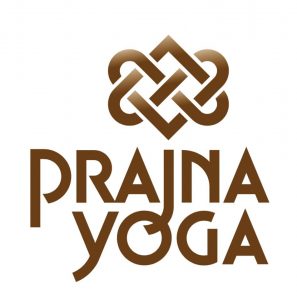
The word prajna is a very old word, akin to the Greek word gnosis. Prajna suggests wisdom, a kind of sixth sense—or seventh sense—not intellectual but an intuitive wisdom. Through prajna one actualizes the dharma in everyday life and engages in the world whole-heartedly without grasping. To use the words of the Chinese sage Mahasattva Fu, one “takes hold of the plow with empty hands.” I founded Prajna Yoga with my wife Surya in Santa Fe, New Mexico, based on our collective forty years of practice and study. The first in-depth study training program in this practice was offered in 1998.
In this day of racy yoga classes, chic yoga wear, and classes that emphasize power work-outs, Prajna Yoga involves mindfulness and precision. In order to tap the internal alignment of a posture, a mindful approach is necessary, and this involves slowing the practice down. By going slowly a student can feel more, and attune to the changing rhythms within her body. We have a bumper sticker we designed that reads: DARE TO BE SLOW. It does take practice—and patience—to go slowly, especially in the midst of the lickety-split, pixel craze in which we all now live.
The aim of yoga is not simply to build strength and flexibility, but intelligence—a kind of somatic wisdom. How do we build this intelligence, this sensitivity? The key in all training, whether headstand, down dog, or seated meditation, is listening. It is through internal listening that one can attune to the subtle body including the breath, holding patterns in the connective tissues, emotions and thoughts. We think of this as the Art of Listening.
Prajna Yoga combines insightful teachings on mindfulness that stem from the Buddhist tradition, with the techniques and practices within Hatha Yoga. The combination of these two are potent means to transform the mind and body. The Prajna approach involves “skillful action” and mindful articulation within a pose.
The practice always begins from the ground up. It is critical to set the foundation of a pose so that it is balanced and stable. Typically this involves the feet, but the foundation of a pose may be the crown of the head, the forearms, or the shoulder blades. When the foundation of a pose is set then one can safely build the temple of the pose.
The Prajna approach is inter-disciplinary and there are many elements woven together in the Prajna practice. One of the primary stitches in the weave is the way hatha yoga combines with the science of anatomy and structural alignment. Techniques from Iyengar Yoga are combined with principles from Osteopathic medicine, the work of Ida Rolf, and elements from Chinese medicine. Also in the Prajna weave are Taoist teachings, yoga for women’s health, nutrition, poetry, and Sanskrit studies. The emphasis throughout is not simply to build a more flexible and stronger student, but to educate students on the nuances of the mind-body-heart connection. The emphasis is to develop “Big Mind”—a mind (and heart) that is wide and broad in its perspective.
One of the things Prajna Yoga avoids is the rigidity of a system. Due to the authoritarianism and the self-serving motivations within any system (something that J. Krishnamurti cautioned against), Prajna Yoga emphasizes a body of practice that changes and evolves. This follows the original teachings of the Buddha who taught that nothing is static, neither the body, the weather, relationships between people, or beliefs. In this sense, the “system” of Prajna Yoga is like the current of a river. This flow can be seen in a variety of ways—the flow of awareness, the flow of vinyasa, the flow of blood and lymph through the body, and the flow of change that happens all the time. This flow also manifests as a practice that can change and adapt according to the needs of the time. In this sense Prajna Yoga is like the Tao and when the Tao flows it is responsive and dynamic.
The cornerstone of the Prajna Yoga approach is metta or loving kindness. The essential practice of kindness does not necessarily involve religion. In fact sometimes the dogma that stems from spiritual practice can become an obstacle to kindness. Metta does not require that one believe in one particular deity. Rather, this kindness manifests when one sees into the fragility of all life and the impermanence of all circumstance. Metta is the ground for being in relationship—within the teacher-student connection, within a marriage, and between co-workers and colleagues. The heart of metta practice involves ease, compassion and non-judgmental awareness toward oneself and others. One student spoke to the Prajna Yoga experience this way, “here is a practice that educates and challenges, but at the same time accepts a person for where they are and works them gently but firmly forward.”
The realization of metta involves the understanding that all life is inter-dependent, something Thich Nhat Hahn called inter-being. The symbol that best describes this is the “knot of eternity,” a weave pattern that best represents Prajna Yoga. This “knot of inter-being” is one of the eight symbols that expresses veneration for the teachings of the Buddha. The knot represents the indivisibility of all of life—all things animate and inanimate, all circumstance, and all activity. Suggested in this symbol is that there is no such thing as an isolated “I” or “me” apart from the weave of everything else. The suggestion of this weave is that the purpose of the path of yoga is not to get outside of or away from one’s relationships in the world. Rather, through understanding the inter-connectivity of all life, one participates more whole-heartedly and fearlessly in the fabric of life.
Prajna Yoga involves a fearless approach to living, yet one that is realized through wisdom and compassion. By training the body to be centered and pliable and the mind-heart to be clear and open, one can live a wondrous and intimate life.
Learn more about Tias Little’s upcoming visit to The Yoga Sanctuary HERE.
